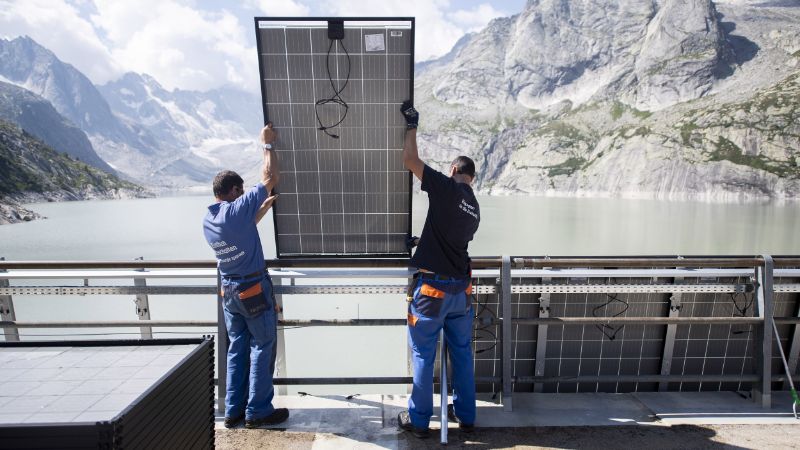The road to Net Zero is rocky, but feasible
The challenge for Switzerland remains: climate change is becoming increasingly visible, the state of biodiversity is alarming to say the least – and the energy transition is stalling again.
The three aspects are closely linked and involve conflicting goals: climate change is threatening biodiversity and therefore our livelihoods. We need the energy transition to mitigate climate change and protect our livelihoods – renewable energies are the key to this. However, their expansion may also have a negative impact on biodiversity, while intact biodiversity protects us from climate change.
The key question regarding Net Zero is therefore: can we stop climate change, preserve biodiversity and secure the energy supply at the same time? From my point of view: Yes, we can, even if it's not easy. In fact, we have to.
The requirements are clear
The climate target was set in the Paris Agreement of 2015. Switzerland has clearly confirmed the net zero target by 2050 with the Climate and Innovation Act (2023) and the expansion of domestic renewable energy with the Electricity Act (2024). The basic principle of sustainable development and the protection of biodiversity are also clearly enshrined in the swiss constitution and the law. Progress is indeed being made in some areas: political measures such as the building program are having an impact, and heat pumps and electric electric vehicles are becoming increasingly attractive. But are we on track?
Implementation is stalling
The short answer is no, we are not yet on track. Neither the world nor Switzerland are doing enough to sufficiently mitigate climate change. We are inadequate in two ways: firstly, the targets are inadequate – we ignore import-related consumption, for example – and secondly, the measures to get there are inadequate. In the case of biodiversity, the challenges are systematically downplayed and it seems as if we are not really aware of the scale of the problem. In terms of renewables, the expansion of solar power has been impressive in recent years, but overall the energy transition is progressing slowly. If you're working on those topics, you can feel it everywhere: the path is steep and rocky.
There are many reasons for this: the implementation of net zero requires patience. Geopolitical tensions and wars mean that national, short-term interests take priority. There is less scope for long-term shared goals. Inflation and pressure to reduce costs contribute to this. Sustainability and reporting on it are costly for companies.
The shift to the right in the Swiss Parliament and the dire nature of the government’s finances mean that almost nothing is moving politically: money for charging infrastructure for electric vehicles has been cut, the building program may be scaled back, and the Parliament did not want a counter-proposal to the biodiversity initiative or an ambitious domestic target for CO2 reductions. The expansion of solar power is slowing down, partly because many people are afraid of negative electricity prices or are unsettled by the debate about nuclear power plants. After all, the easiest way to earn money at the moment is with fossil fuels and weapons.
The struggles are also affecting communication. Companies are hesitant or no longer talk about their efforts for fear of criticism. This is known as greenhushing.1 It is a fatal development if we criticize the pioneers because they are not perfect instead of supporting and learning from them.
There are many solutions
Some of the points above are beyond our control, but the biggest hurdles lie with ourselves. A recent study2 examined possible barriers and concluded that the biggest hurdles are not technological or financial, but institutional, social and political: We think short term, are afraid of change, stand in each other's way and fail to establish a political framework in which this transformation can take place. This is despite the fact that many measures are economically attractive in the long term because the benefits exceed the initial investment.
It also isn’t a lack of awareness of the problems. We largely agree that the challenges of energy, biodiversity and climate must be solved, but we are divided, or at least at a loss, as to how.
Finding and discussing optimal paths
As scientists, we can contribute to the solution in several ways: firstly, by helping to examine facts, evaluate options and pragmatically apply the often abstract considerations to local situations in Switzerland.
Secondly, by overcoming the tendencies to work in silos and looking for approaches that satisfy different interests and requirements. Which energy infrastructure makes sense where, so that biodiversity does not suffer? How do we combine protection and use, especially in the Alps?
And thirdly, by not only communicating potentially consegfnsual solutions, but also making them publicly accessible, supporting political processes and providing space for dialog and debate. In short, we should not dictate anything, but actively contribute to proposals.
It is precisely these questions and interfaces that we are studying with interdisciplinary focus in SPEED2ZERO, a Joint Initiative of the institutions of the ETH Domain. Its aim is to tackle current challenges in the areas of climate, biodiversity and energy security together and to enable a sustainable transition towards a climate-friendly and biodiversity-rich Switzerland.
Switzerland does not lack knowledge, technology or money, we primarily have an implementation problem. A broad exchange between society, politics and science can help to resolve such hurdles. This is what we are committed to.
